A 501(c)(3) charitable organization. Copyright © 2006 to Present OC Hiking Club/Hike Everywhere, All rights reserved. Distribution or publication of this site's content without prior written permission is prohibited.
PLANTS IN SOUTHERN CALIFORNIA
Plants in Southern California
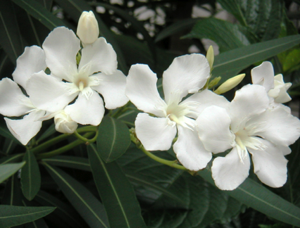
Plants, like other living organisms, compete for scarce resources in their environment and must defend themselves from predators. Lacking mobility, plants rely upon physical and chemical means to accomplish these goals.
Sometimes people become the victims of these physical and chemical defenses; it is a good idea to be prepared prior to heading out on the trails.
4 simple rules
- Do not eat plants, berries, fruit or mushrooms on the trail
- Avoid handling plants on the trail
- Do not use native plants as firewood
- Wear protective clothing
Potentially Poisonous Plants and Fungi
Below is a list of poisonous or potentially poisonous plants and fungi.
- Avoid milky sap
- Avoid all mushrooms and fungi
- Avoid umbrella shaped flower clusters (hemlock)
- Avoid beans & peas
- Avoid bulbs
- Avoid white & yellow berries (almost always poisonous)
- Approximately half of red berries are poisonous (blue and black berries generally safe)
- Plants with shiny leaves should be considered to be poisonous
- Food from your pack is safe, don’t eat plants you don’t know
Firewood
Many campsites require that you pack in your own firewood.
Do not use wood from plants on the trail in your campfire unless you are certain it is not from a poisonous plant.
Oleander is a very common ornamental plant and one of the most poisonous. You can often see it planted along Southern California freeways.
People have died from using an oleander stick to roast a hot dog over a campfire.
Allergies
Symptoms of Mild Allergies/Hay Fever
Mild allergies and hay fever are more of an annoyance than anything. The symptoms are:
- Sneezing
- Red, itchy eyes
- Runny or itchy nose
- Throat irritation or itchiness
- Difficulty breathing (in moderate allergies)
Treatment & Prevention of Allergies
Mild or moderate allergies can often be self treated by quick-dissolve or chewable allergy pills, or strips which deliver the medication through your system more rapidly.
Be aware that some over the counter allergy medication (such as Benadryl) may cause you to feel drowsy or anxious and should be taken only when you know how you react to them.
- Bring along your allergy medications
- Those with asthma should always have their rescue inhaler(s) on hand
- Decongestant
- Topical Hydrocortisone cream
Severe Allergies
Some allergies can be life threatening if they are severe.
- Varying degrees of swellings that can make breathing and swallowing difficult
- Abdominal pain
- Cramps
- Vomiting
- Diarrhea
- Mental confusion or dizziness
- Anaphalaxis
Anaphylaxis is a serious, potentially life-threatening allergic response that is marked by swelling, hives, lowered blood pressure and dilated blood vessels. In severe cases, a person will go into shock. If anaphylactic shock isn't treated immediately, it can be fatal.
Those with severe allergies should plan ahead:
- ask your doctor for a prescription for an epi-pen
- know what triggers your severe allergies
- wear a warning bracelet
- let people you hike with know about your allergies
- carry the name/number of an emergency facility near the hike location that can treat you and how to help if you have a severe attack.
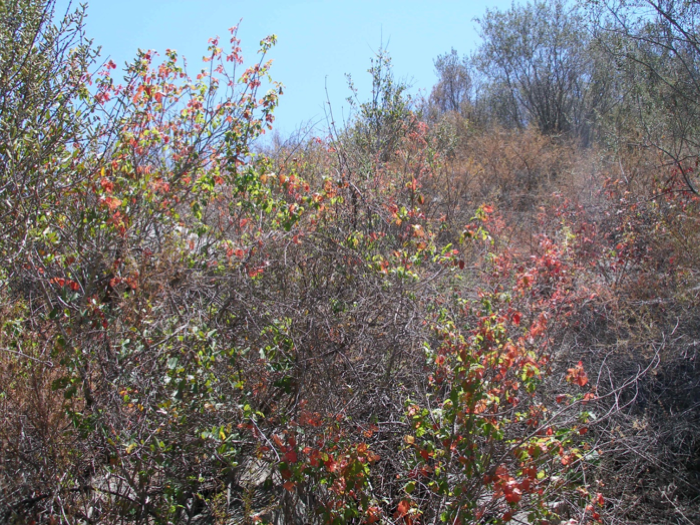
Western Poison-oak aka Pacific Poison-oak
“Leaves of 3 — Let them be!”
The only variety of poison-oak found in Southern California is “Western Poison-oak” also known as “Pacific Poison-oak.” Poison-oak is not a variety of oak, so the spelling includes a hyphen to distinguish it as a separate type of plant.
Poison-ivy and Poison Sumac are not found in Southern California.
The common factor is the poison, a toxic oil – urushiol. While some people have no sensitivity, many people become increasingly sensitized with repeated contacts, developing an allergic rash.
How to Identify Poison Oak
Western Poison-oak can grow as a shrub or vine. Any trail to a waterfall may have poison-oak present.
- lobed leaves similar in appearance to actual oak leaves
- grow in sets of three leaflets
- the glossy, shiny leaf surface
- initially bright green but changing throughout the seasons often to a mix of green and bright red with some yellow
- found in damp, shady areas near water and out of direct sunlight.
Prevention of Poison Oak
- Barrier protection works well
- Long sleeved shirts and full length pants.
- Any of part of your gear that comes into contact with poison-oak may become contaminated with its oils and it can spread by means of this secondary contact.
- Smoke inhaled from poison-oak burned in campfires can initiate a reaction.
Symptoms of Poison Oak
- moderate to severe itching
- inflammation
- bumps
- blistering (when scratched)
Treatment of Poison Oak
- Tecnu is a product line of Tec Labs, Inc. which offers cleansers and post exposure treatments.
- Hydrocortisone cream can be effective in relieving symptoms.
- Go to a doctor if you believe you have come in contact with poison oak and the itching is severe. Some people are highly allergic to this plant and complications can occur.
Stinging Nettles
Stinging Nettles are characterized by hair-like structures that act as tiny hypodermic needles injecting a variety of toxins. Avoid this plant at all costs, it will “sting” you and one touch can cause days or weeks of suffering. It is not particularly dangerous, but it is very unpleasant.
How to Treat Stinging Nettles
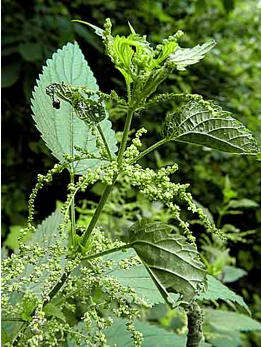
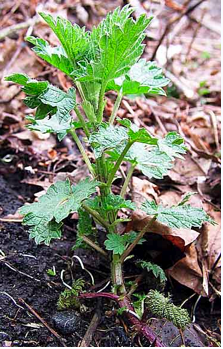
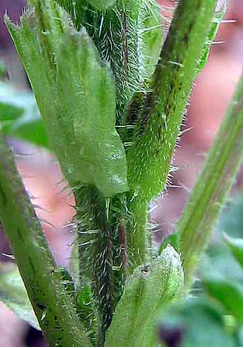
Can effectively be treated with any number of anti-itch creams of drugs.
Jumping Cholla
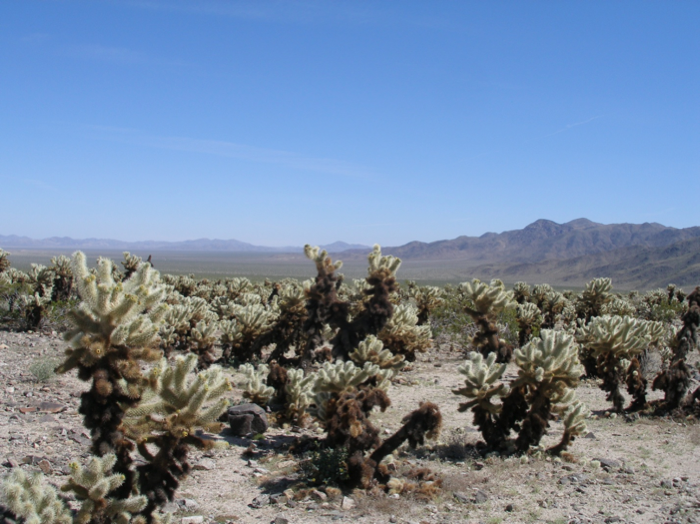
The Jumping Cholla is also known as the Hanging Chain Cholla but is often used to refer to all varieties of cholla.
The name “Jumping Cholla” comes from how quickly and easily pieces detach when brushed, as if it jumped onto you.
A slight touch will leave you with cactus hanging on your pants, boots or you!
How to Remove a Cholla
Once a Cholla has attached itself to you it can be difficult to remove. A pocket comb is an excellent way to remove this type of cactus, but take care not to flick it onto your friends.

PRICKLY PEAR (foreground); Flowering Yucca (background)
Prickly Pears have long spines that can become imbedded in anything they come in contact with. To pull the spines out, you may want to carry pliers or tweezers as part of your standard gear.
YUCCA
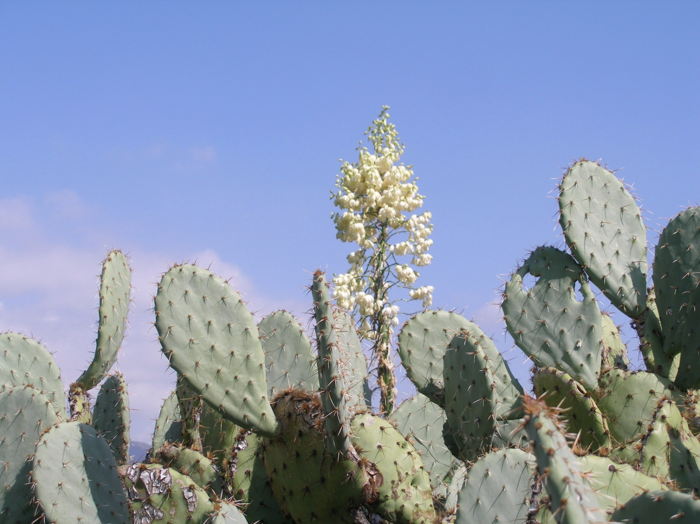
The 40 to 50 species of plants that comprise the genus Yucca from the Agave have broad sword shaped leaves that can be dangerous if you walk into one.
These plants are most often noticed by hikers when their dagger-like leaves pierce their shins.
Jimson Weed
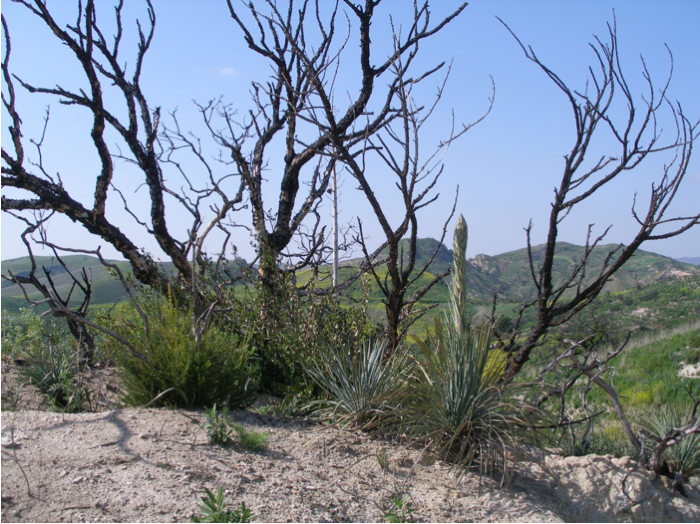
Jimson Weed is entirely toxic. Its seeds have been used deliberately to induce intoxication or hallucinations.
Symptoms of Jimson Weed Poisoning
- dry mouth
- dilated pupils
- dry warm skin,
- reddening of face/neck
- irregular heart rhythms
- delirium
Go see a doctor immediately if you think you have ingested Jimson Weed
Mushrooms
Do not eat mushrooms growing in the wild. There is no easy way to tell which mushrooms are poisonous or safe.
Even if you only think that someone has eaten one, call the poison control center. Symptoms of a serious poisoning may not appear until many hours later. Do not wait until symptoms appear.
A 501(c)(3) charitable organization. Copyright © 2006 to Present OC Hiking Club/Hike Everywhere, All rights reserved. Distribution or publication of this site's content without prior written permission is prohibited.




